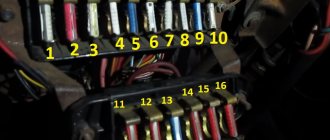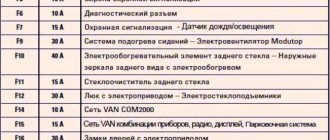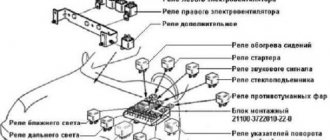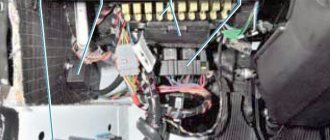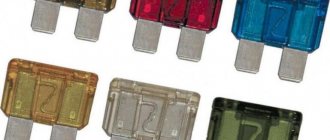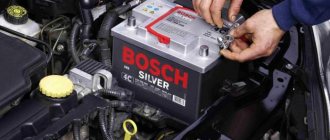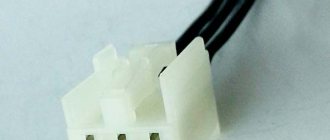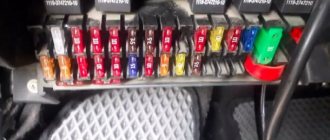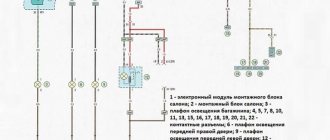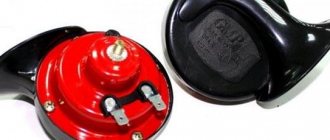Hyundai Accent fuse box: what each element is responsible for
This brand of car has numbered markings of safety elements, which are located in a clear sequence - the functional purpose of the fuse in each block is easily identified from the following list:
No. Passing power, A Functional purpose
| 1 | 10 | The element is responsible for the turning system, as well as duplicating turns and electrically adjustable side-view mirrors if these functions are included in the vehicle configuration |
| 2 | 10 | A technical fuse that regulates the operation of the anti-lock braking system sensors and instrument panel indicators. As a rule, if this part comes out, the car will not be able to start - this is done for safety reasons. |
| 3 | 10 | The element is responsible for the operation of the instrument cluster circuit |
| 4 | 15 | 15-amp fuses are designed to prevent short circuits on the sensors and squibs of all airbags present in the vehicle interior |
| 5 | 10 | A technical element responsible for the operability of the engine electronic control unit systems, as well as the automatic transmission control unit if it is included in the configuration |
| 6 | 10 | The fuse is responsible for the operation of the door position sensors and the central locking remote control system |
| 7 | 10 | This element in the system is responsible only for the operation of the alarm and braking signals |
| 8 | 10 | Protecting the headlight relay coils, power windows, climate control or air conditioning compressor, as well as fog lights and tail lights against short circuits |
| 9 | 20 | The element protects headlight or windshield wipers, as well as wipers and heated windshields from voltage surges |
| 10 | 10 | Reserve socket, which is used when connecting new equipment in a car or to reduce the current load on other fuses |
| 11 | 20 | An element responsible for protecting the cigarette lighter in a car from burnout or short circuit. As a rule, failure occurs several times per season due to the cigarette lighter being overloaded with various gadgets |
| 12 | 10 | Air conditioning circuit fuse. Used if block element No. 8 is already overloaded with other equipment |
| 13 | 10 | Used for separate protection of multimedia equipment - audio systems, all-round cameras or multimedia console |
| 14 | 10 | Auxiliary fuse for the heated seat option. If this function is not included in the configuration, the car is a backup |
| 15 | 10-20 | Reserve socket, which is used when connecting new equipment in a car or to reduce the current load on other fuses |
Important to remember! If any of the car’s functions does not work, before disassembling the vehicle’s equipment, it is important to check the integrity of all fuses in the blocks - as a rule, these elements regularly fail when saving on a high-quality battery or as a result of “handicraft” tuning and connecting a lot of additional gadgets.
01/18/19 Won’t start (fuel pump relay in the cabin) — Hyundai Accent, 1.5 liter, 2008 on DRIVE2
So, one fine morning the car wouldn’t start; maybe the Akum froze. The next day we lit a cigarette and screw it. And the fuel pump is treacherously silent. We went to Pulmart on Yaroslavka, there is a spare parts store for basins on the second floor. They sold us this one for 900 rubles
Full size
Full size
says: great fuel pump, they take everything, no complaints. But there’s just something wrong with him... is he a two-year-old? for a two-piece, but it doesn’t fit into the pump housing and that’s it. On another occasion, I burned five of them in a year, all of the two-piece were (different) how they worked - the second question, but they all sat in their place in the bottom cap, and the mesh became normal. As a result, I removed the ring from the flange of the coarse mesh, tightened it somehow, and still did not sit down. Here's a pipe that costs a cent, the axle is long, I wanted to shorten it with wire cutters, it broke like hell, the quality is worthy of a basin. It doesn't matter - it shouldn't affect the work - I assembled it, all this happens in the cold outside, oh yes - I only managed to pull the hose onto the top flange At the same time, I nicked the plastic of the connector halfway. Did everyone understand that after such torment and manipulation you won’t have any complaints against the seller? Yep, that's right. Does not start. It's time to check with a multimeter where the voltage is))) - but there is none. Okay. Is the fuel pump working? They connected the wires directly to it - it’s silent, hmm... we’ve arrived. They threw wires on the old one - it works. The first thousand went to the mountains. They thought the signaling system was making a head, they dug under the tidy, but didn’t find anything until they gave up on this idea. The next idea is something with the brains, they threw it from the cherry one, it didn’t help, they connected it from the black one to the cherry one, the brains work, and the check does not light up, no errors. A small digression - the black check has been on for a year now. The error is the absorber valve, the valve is new (original), the absorber is new (original), the previous ones are intact, they said that there are some shortcuts in the brains, but today we are convinced that our brains are faulty everything is fine))). If anyone gives us some versions, we’ll consider it, thanks in advance.
Let's return to this situation, DPKV,
Here he is
DPKV is to blame for everything, they found AMD for 600 rubles. My brother installed it himself, I had to struggle to get there, and voila! It wouldn’t start))) At night my brother found where we have the fuel pump relay
Here it is
It's the same
And this is it too
Yes, yes, yes, this is it too
... well, you understand
A simple five-pin connector fits there from the basin, they threw it in with an additional signal - well, it won’t start. The next day we bought the original and it won’t start. And then an acquaintance decided to keep him company (let’s call him Slavik), he said, Basins with the tidy not connected won’t start, I don’t know.
Well, how was I to know... It started up. Let's summarize: problems with the pump? Above the brains, behind the small glove compartment, the fuel pump relay is screwed onto the body upside down, so all the condensation, or leaking glass (depending on whoever) flows into it - and that’s it. Of course, they didn’t screw it back, I pulled it together with electrical tape to the wiring harness, under these bolts there is one more ground terminal - you need to put it back. And with all attempts to start, we connect the tidy! Why did you remove it? We were looking for a signal, why didn’t we attach it? and why? - suddenly the signaling system really shut down - it’s impossible to disassemble it a second time.
Full size
For history
Thank you for your attention.
Where are the Hyundai Accent fuses located?
Replacing damaged elements in the safety block will not be difficult - the whole procedure is simple and follows an intuitive script. The greatest difficulties for drivers arise when searching for a damaged element - 2 or 3 units can be installed on different generations of Hyundai Accent.
Depending on the model, there may be 1 or 2 blocks in the car interior; a separate block will be located in the engine compartment:
- The first interior unit is located near the driver's seat on the left side - to ensure easy access you will have to remove the decorative trim in the car's dashboard;
- The second fuse box will be located behind the additional glove compartment in the cabin. In some versions of the Hyundai Accent there will be only a few relays located there, in others there will be a relay and several fuse cells;
- Under the hood the block is located on the left side of the engine. All fuses under the hood are located in a sealed box, which is secured with plastic latches - when dismantling it is important not to damage the fastenings, otherwise moisture will quickly enter the system, which will lead to corrosion of the block itself and oxidation of the chips.
To make it easier to find a faulty element, you need to remember that in the engine compartment there will be fuses responsible for the main wiring, engine and electrical equipment of the car, and in the passenger compartment there will be protective elements for additional equipment and equipment options.
The problem with starting the engine has been solved — Hyundai Accent, 1.5 l., 2009 on DRIVE2
And so ladies and gentlemen, I’ll tell you a fascinating story. It all started one beautiful spring morning. There was fog outside and there was terrible dampness that penetrated wherever possible. I was getting ready for work. I went out, got into the car and turned the ignition key. I immediately noticed that the fuel pump did not turn on. I started looking for the problem. I removed the rear seat, pulled the contacts to the fuel pump, checked the switch, everything seemed to be working. Repeated attempt to start, turned the starter for 5 seconds and started. I thought that the dampness had done its job, hence the problem. After work, I go out again happy, get ready to go home, and here again the same picture, the engine won’t start. After several attempts to start it, nothing happened. I left the car at the office, until the next one. day. In the evening I diligently read forums and blog entries in order to find out what the problems were and what could lead to such a problem. The next morning I rushed to the office to bring my machine to life. I started work with the mounting block, 1) tried to swap the fuel pump relay - the result was negative 2) I opened the jumpers and discovered oxidation of the contacts. I took it off, cleaned it, installed it - the result was negative. 3) Checked whether the fuel pump is working. I removed the terminals and connected the fuel pump directly from the lampshade. Everything works. Let's move on 4) I removed the cover from the steering column and took off the IMMO antenna, disassembled it. And it turned out to have no obvious faults. We called, everything is OK, everything works. 5) Removed the main start relay. Having opened it, it turned out that there was condensation and oxidation inside. Washed it, dried it, installed it and it doesn’t work. The relay is attached to the housing and condensation drains from it and goes directly into the relay. Structurally, the location of the RELAY is incorrect. I didn’t attach it to the body, but rather moved it as far away from the body as possible so that such a problem would not arise. Which is what I recommend to everyone. 6) We bought a new relay and installed it and VOILA everything worked. It turns out that this relay solves everything. Without it, the IMMO does not work, the injectors do not work and the fuel pump does not work. This is the story that happened to my Ax. A lot of effort and nerves were spent, but the most important thing is a positive result. Good luck to everyone on the roads. Below are photos of a non-working relay.
Price: 100,500 ₽ Mileage: 96,698 km
Fuses and relays HUNDAI ACCENT
Relay and fuse mounting block in the engine compartment
1 - fuse 100 A generator circuit; 2 - 50 A complex fuse (electric circuits for door lock, alarm, brake signals, heated rear window, sound signal, interior lamp, ECU); 3 - 30 A fuse for the head and side light lamp circuit; 4 - 20 A fuse for the engine control unit circuit; 5 - 30 A fuse for the engine starting circuit and ignition coils. 6 - 20 Amp fuse for the radiator fan circuit of the engine cooling system, 7 - electrical wiring connector, 8 - heater fan relay. 9 - horn relay, 10 - 10 A fuse for the Hyundai Accent interior lamp circuit. 11 - 10 A fuse for the head unit circuit of the sound reproduction system. 12 — relay 2 of the air conditioning condenser heat exchanger fan, 13 — air conditioning compressor clutch relay, 14 — fog lamp relay socket; 15 — reserve fuse socket; 16 - 15 A fuse for idle speed control and camshaft position sensor. 17 - 10 A fuse of the engine control unit circuit. 18 — radiator fan relay for the engine cooling system; 19 - 10 A fuse for the air conditioner switching circuit; 20 — relay 1 of the condenser heat exchanger fan of the air conditioning system; 21 - 10 A fuse of the engine control unit circuit, 22 - 10 A fuse of the air conditioning compressor clutch circuit, 23 - 10 A fuse of the horn circuit; 24 - 15 A fuse for the fog lamp circuit. 25 - 10 A fuse for the right headlight lamp circuit. 26 - 10 A fuse for the left headlight lamp circuit; 27 - 10 A fuse for the side light lamp circuit on the right side of the car; 28 - 10 A fuse for the side light lamp circuit on the left side of the car; 29 — side light lamp relay; 30 — generator pre-excitation resistor; 31 — Hyundai Accent starter relay, 32 — 20 A fuse for the condenser heat exchanger fan circuit, 33 — 30 A fuse for the electric window circuit. 34 - 30 A fuse of the ABS control unit circuit; 35 — relay socket for always-on low beam; 36 — fuel pump relay; 37 - 30 A fuse of the ABS control unit circuit; 38.39 - diode socket; 40 - 30 Amp fuse for the heater fan circuit.
Connection diagrams
Diagram of wiring harnesses routed along the body
1 — 12 V power supply 2 — 12 V power supply, main engine control relay on 3 — 12 V power supply, ignition on 4 — fuse and relay box (engine compartment) 5 — interior fuse box 6 — heater fan fuse 7 — air conditioning compressor clutch fuse 8 — power window fuse, windings of the headlight relay, headlight washer, air conditioning condenser heat exchanger fan, radiator fan, front and rear fog lights
9 - heater fan relay10 - connector11 - to headlight washer relay12 - air conditioner compressor clutch relay13 - connector14 - to interior relay block15 - automatic transmission control unit16 - interior fuse block17 - air conditioner fuse18 - heater fan motor19 - engine control unit (ECU)20 - from block on the dashboard wiring harness21 - heater fan motor resistor (heater operating modes)22 - pressure-operated switch23 - air conditioning switch24 - air conditioning compressor clutch25 - from the block on the dashboard wiring harness26 - heater speed switch (heater fan operating modes)27 - thermal switch28 , 29 - to the block on the dashboard wiring harness
Fuse box in the engine compartment
The mounting block is located on the left side, between the air filter housing, battery and body. To repair your car yourself, you need to be able to read electrical diagrams. Fuses are used to protect circuits from short circuits. List of fuses located in the engine compartment:
- F1 – generator circuit protection (rated 100 A). When this fuse fails, the battery begins to discharge faster. If there is no charge at the battery terminals, it is necessary to check the belt tension, the contacts on the generator, the condition of the brush assembly and the voltage regulator.
- F2 – protection of the door lock circuit. The fuse rating is 50 Amps. It also protects the power supply circuits for the alarm system, horn, heating element on the rear window, microcontroller engine control unit, interior lighting, and various electric drives (including mirrors). Therefore, if the brake light, sensors on the Hyundai Accent do not work, the car does not start, the first thing you check is this fuse. If the alarm system fails, you need to check fuses No. 1 and No. 7 located in the cabin block. If they are working properly, then you need to diagnose relay No. 10. The last thing to diagnose is the button and wiring.
- F3 (30 Amperes) – designed to protect the power supply circuits of the head light and side lights. In the event of a lighting failure, it is necessary to check fuses No. 27 and 28, as well as relay No. 4, which are located in the passenger compartment.
- F4 - this fuse supplies power to the motor control unit. Rated current 20 A. If the engine cannot be started, you need to check this fuse. Only after F5, F6, F16, F17, F18, F21 and in the cabin F5 and electromagnetic relay 3.
- Through F5 (30 Amperes) power is supplied to the ignition coils.
- Through F6 (20 A) and F18, power is supplied to the radiator fan electric motor.
- F10 (10A) – power supply for interior lighting circuits.
- F11 (10A) – protection of the car radio power circuit.
- F16 protects the power supply circuits of the DPRV (phase sensor) and IAC (idle air regulator). Rated current 15A.
- F17 – power is supplied to the ECU through it. View information on F
- F19 (rated 10A) – power supply to the air conditioner control circuits.
- F21, F22, F23 (all rated 10A) - protection of ECU circuits, air conditioning compressor clutch, sound signal, respectively.
- F24 – fog lights.
- F25 and F26 (10A) – head lighting on the left and right sides, respectively.
- F27 and F28 (10A) – side lighting lamps on the right and left sides, respectively.
- F32 – protection of the air conditioner condenser heat exchanger fan circuit.
- F33 – power supply circuit for electric windows.
- F34 and F37 – ABS control unit (if equipped).
- Heating fan – F
That the rear window heating does not work
If 12 V voltage from the battery is applied directly to the required wires, the radio should turn on. If it does not turn on, there is most likely a fault inside it and requires repair or replacement. If the air conditioner stops working, check in addition fuses 13, 19, the heated rear window of the Hyundai Accent does not turn on, 22, 32, as well as fuses 10 and in the cabin unit. If they are all working, there may be no freon in the system and need to be refilled.
It would be a good idea to check the entire system and tubes for leaks and tightness. In winter, it is recommended to turn on the air conditioner occasionally to avoid problems with it in the spring. Also look at the compressor under the hood; when the mode is turned on, its clutch should spin. If it does not spin, either there is no freon, or one of the components of the system is faulty. If none of the fog lights work, check also fuse 24, then fuse 10 and relay 2 in the interior block.
The front and rear PTFs are activated using different buttons. Check the contacts and serviceability of the corresponding button on the dashboard, as well as the wiring. If the engine does not idle, does not start, stalls, or runs erratically, check this fuse, as well as the fuel system and fuel pump. The reason may be, in addition to the heated rear window of the Hyundai Accent not turning on, low-quality fuel, spark plugs, injectors and other components. If you have no experience, it is better to contact a diagnostic station.
If both headlights do not work, see If one headlight works and the other does not, check one of these fuses, as well as the condition of the lamp and the contacts in its socket. If none of the clearance lamps light up, see
If the lamps do not light on only one side of the car, check one of these fuses, the lamps and their connectors. If you turn the ignition key and the starter does not turn, check this fuse. If it is working, check the battery charge and the fastening of the terminals on it.
They could oxidize or relax. Clean them inside with sandpaper or a round file and secure them well to the battery terminals. If after this the starter does not start turning, the heated rear window of the Hyundai Accent does not turn on by closing 2 contacts with a screwdriver or a metal object. Before doing this, make sure that the gearshift lever is in the neutral position.
If the battery is charged and the starter does not work when the contacts are closed or 12 V is applied directly to it, it is most likely faulty. In this case, repairs can be helped by replacing brushes or other worn parts or buying a new one.
If the starter operates only with direct voltage applied, check the wiring and ignition switch. Perhaps the tracks in the lock have oxidized or there is no contact in the connector.
If none of the power windows work, check, in addition to this fuse, relay 7 in the passenger compartment. If the window lifter does not work in one of the heated rear windows of the Hyundai Accent Door, check the wires between the door and the body; often in this place they break; the control buttons on the door, as well as the lift mechanism itself.
To get to it, you need to remove the door trim. All cables must be in their grooves, the gears do not turn on, the heated rear window of the Hyundai Accent must be intact and the engine must be running. Also check that there are no foreign objects in the mechanism. If the ABS system stops working on slippery surfaces and the wheels lock when braking, check this fuse.
If it is intact, the problem may be in the ABS unit, which is located under the air filter. The motor could fail or its brushes could wear out. If both low beam headlights do not work, check this relay, as well as the lamps and wiring. Check each of the lattice threads one by one. If there are no breaks, connect the negative probe to the chassis ground and repeat the test - the readings should not change, otherwise there is a violation of the quality of the grid grounding.
To localize the break, press the negative probe of the voltmeter to the negative terminal of the heating element grid. Using a positive probe wrapped in foil, begin to probe the conductive threads of the grid, moving from the side of the power supply to ground. At the break point, the meter reading should drop from a few volts to zero.
Before you begin restoring the work element grille, turn off the heater and allow the element to cool for a few minutes.
Fuse box in the passenger compartment
The above information about fuses is quite enough to get rid of major breakdowns in electrical equipment. We must remember that the weakest link always fails. If you first install a 30A fuse, and then install it at 10A, in the event of a short circuit, the one with the lower operating current will fail. The second one will remain safe and sound. A block is placed under the hood that protects power circuits - several units at once. Fuses in the cabin
But in the cabin, fuses are installed to protect individual lamps and even devices. Table with characteristics and purpose of fuses:
| Fuse number | Rated operating current, A | What circuits does it protect? |
| F1 | 10 | Turn signals |
| F2 | 10 | ABS system and lamps on the car dashboard |
| F3 | 10 | Power supply for instruments on the dashboard |
| F4 | 15 | Airbags |
| F5 | 10 | ECU, reverse warning lamps, automatic transmission control (if equipped) |
| F6 | 10 | Central locking, door lock drives |
| F7 | 10 | Emergency crew |
| F8 | 10 | Stop signal |
| F9 | 20 | Heating element on the rear window |
| F10 | 10 | Electric windows, headlight washers, radiator and heat exchanger fans, headlight relay coils, fog lights |
| F11 | 20 | Windshield washer and wiper |
| F12 | 10 | Seat heating element |
| F13 | 10 | ABS |
| F14 | – | Reserve |
| F15 | 15 | Cigarette lighter |
| F16 | 10 | Electric mirror drive |
Relay box in the cabin
Relay in the Hyundai Accent interior
The block with electromagnetic relays is located in the cabin, right behind the small glove box. Description and purpose (according to the picture):
- Activation of the EBD (brake force distribution) system.
- Turn on the rear fog lights.
- Main relay COURT.
- Head lighting.
- Windshield wiper and washer.
- ABS activation.
- Electric windows.
- Heated rear window.
- Klaxon.
- Turn signals and hazard lights.
For the Accent model, the electrical diagrams can be found in the manual. The article provides only diagrams of the location of fuses and electromagnetic relays located in the mounting blocks of the engine compartment and passenger compartment.
Decoding
Scheme with decoding.
F1 ( red 10 A) - Turn indicators F2 ( red 10 A) - ABS system, control and warning lamps in the instrument cluster F3 ( red 10 A) - Instrument cluster F4 ( blue 15 A) - Airbag F5 ( red 10 A) - engine control unit, automatic transmission (if equipped), reverse lamps F6 ( red 10 A) - Door lock drive F7 ( red 10 A) - Hazard alarm F8 ( red 10 A) - Brake light lamps F9 ( yellow 20 A ) — Rear window heating F10 ( red 10 A) — Relay coil for headlights, power windows, headlight washer, air conditioning heat exchanger fan, radiator fan F11 ( yellow 20 A) — Windshield cleaner and washer F12 ( red 10 A) — Heated rear seat F13 ( red 10 A) — ABS F14 ( blue 15 A) — Cigarette lighter and audio system F15 ( red 10 A) — Electric exterior mirrors F16 ( red 10 A) — Air conditioning system
The Koreans drew this diagram.
How to extract?
To remove fuses, there is a special tool in the block - tweezers. They need to pinch the edge of the fuse and pull it out. There are duplicate tweezers in the block under the hood.
Tweezers.
How to replace fuses in a Hyundai Accent: step-by-step instructions
The procedure for replacing fuses in the block is simple - to remove a damaged element, you only need tweezers or a special puller; no other equipment is required. To replace fuses on a Hyundai Accent you need:
- Be sure to disconnect the battery, both terminals;
- Next, we find the burnt out element and carefully remove it;
- If necessary, you can use a rough brush to clean the contacts in the block from oxidation;
- Then we press the new part onto the connector in the block until we hear a characteristic click.
At the end of the procedure, connect the battery and start the car to test the system. If the fuse of the recommended power blows out immediately, then you may need to take the car to a service station to diagnose electrical equipment and wiring.
